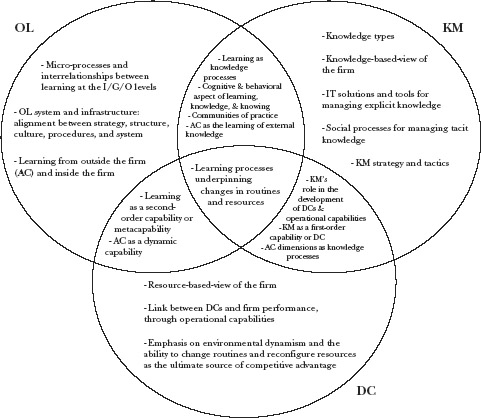Definition of Boundaries
Figure 8.2 summarizes our conclusions about the domains and boundaries of the OL, KM, DC, and AC fields. We see these boundaries as fluid. They will evolve as the dialogue between members of these fields continues.
Figure 8.2 Boundaries of the Organizational Learning (OL), Knowledge Management (KM), Dynamic Capabilities (DC), and Absorptive Capacity (AC) Fields

In Figure 8.2, we show OL, KM, and DC as overlapping fields of research, but we recognize that there are topics that are dealt with primarily in one of the fields, and topics in which one field is more advanced in its development than the others. For example, we see OL as the most advanced in terms of providing a multilevel theory of learning in organizations. We also note that OL advances the view of an OL system or infrastructure where organizational level storehouses of knowledge—strategy, structure, systems, culture, and procedures—are aligned. In contrast, we see the KM field focused on creating a knowledge-based view of the firm, where the creation and integration of knowledge is the reason why firms exist. Similarly, the dynamic capabilities perspective is unique in providing a dynamic perspective of the resource-based view of the firm and in suggesting the ability to change routines and reconfigure resources (including knowledge routines and knowledge resources) as the ultimate source of ...
Get Handbook of Organizational Learning and Knowledge Management, Second Edition now with the O’Reilly learning platform.
O’Reilly members experience books, live events, courses curated by job role, and more from O’Reilly and nearly 200 top publishers.

